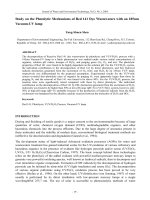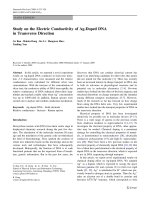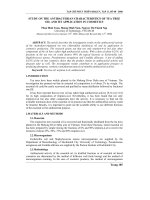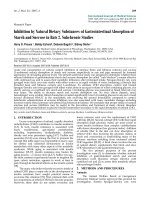Study on the intestinal absorption of small and oligopeptides in rats (LV thạc sĩ)
Bạn đang xem bản rút gọn của tài liệu. Xem và tải ngay bản đầy đủ của tài liệu tại đây (2.44 MB, 107 trang )
Study on the intestinal absorption of small
and oligopeptides in rats
Vu Thi Hanh
Kyushu University
2017
List of contents
Chapter I
Introduction .........................................................................................................1
Chapter II
Application of a standard addition method for quantitative mass
spectrometric assay of dipeptides ....................................................................17
1. Introduction .....................................................................................................17
2. Materials and Methods ....................................................................................21
2.1. Materials and instrumentation ......................................................................21
2.2. Preparation of peptide standard and soybean hydrolysate solutions ............22
2.3. Derivatization of dipeptides with TNBS ......................................................22
2.4. LC-TOF-MS analysis ...................................................................................23
3. Results and Discussion ....................................................................................24
3.1. ESI-MS detection of intact and TNBS-derivatized dipeptides ....................24
3.2. Application of a standard addition method for quantitative MS assay of
dipeptides in soybean hydrolysate .......................................................................30
4. Summary .........................................................................................................36
i
Chapter III
Intestinal absorption of oligopeptides in spontaneously hypertensive rats .37
1. Introduction .....................................................................................................37
2. Materials and Methods ....................................................................................39
2.1. Materials .......................................................................................................40
2.2. Animal experiments .....................................................................................40
2.3. Determination of absorbed oligopeptides in plasma ....................................41
2.4. Statistical analyses ........................................................................................43
3. Results and Discussion ....................................................................................43
3.1. Absorption of a tripeptide model Gly-Sar-Sar in spontaneously hypertensive
rats .......................................................................................................................43
3.2. Absorption of oligopeptide models Gly-Sar-Sar-Sar and Gly-Sar-Sar-SarSar in spontaneously hypertensive rats ...............................................................48
4. Summary .........................................................................................................54
Chapter IV
Effect of aging on intestinal absorption of peptides in spontaneously
hypertensive rats ................................................................................................55
1. Introduction .....................................................................................................55
ii
2. Materials and Methods ....................................................................................57
2.1. Materials .......................................................................................................57
2.2. Animal experiments .....................................................................................57
2.3. Determination of absorbed peptides in plasma ............................................58
2.4. Western blotting analyses .............................................................................61
2.5. Statistical analyses ........................................................................................63
3. Results and Discussion ....................................................................................64
3.1. Effect of aging on absorption of di-/tripeptides in spontaneously
hypertensive rats ..................................................................................................64
3.2. Effect of aging on PepT1 expression in spontaneously hypertensive rats ...72
3.3. Effect of aging on absorption of oligopeptides Gly-Sar-Sar-Sar and GlySar-Sar-Sar-Sar in spontaneously hypertensive rats ...........................................74
4. Summary .........................................................................................................79
Chapter V
Conclusion ..........................................................................................................81
References ..............................................................................................................86
Acknowledgements .............................................................................................101
iii
Abbreviations
ACE, angiotensin I-converting
enzyme
PepT1, proton-coupled peptide
transporter 1
ACN, acetonitrile
m/z, mass-to-charge ratio
AUC, area under the curve
SBP, systolic blood pressure
Cmax, maximum concentration
SD, Sprague-Dawley
EDTA,
SHR, spontaneously hypertensive
ethylenediamine
tetraacetic acid
rat
ESI, electrospray ionization
S/N, signal-to-noise ratio
FA, formic acid
SEM, standard error of mean
IS, internal standard
TJ, tight-junction
LC, liquid chromatography
tmax,
LOD, limit of detection
LOQ, limit of quantitation
t1/2, elimination of half-life
MeOH, methanol
TNBS,
MRM,
multiple
MS/MS,
maximum
tandem
2,4,6-trinitrobenzene
sulfonate
reaction
mass
spectrometry
for
concentration
monitoring
time
Papp, apparent permeability
iv
TNP, trinitrophenyl
TOF, time of flight
Chapter I
Introduction
In the modern society, lifestyle-related diseases concomitant with
chronic diseases, such as atherosclerosis, heart disease, stroke, obesity, and
type 2 diabetes, have been rapidly increased as a critical public health issue in
the world [1]. It is estimated that there are approximately 60 million deaths
worldwide each year, in which over half are related to lifestyle-related diseases.
The classes of diseases can be improved by lifestyle changes and early
treatments such as healthy diet, non-smoking, reducing excessive alcohol use,
reducing stress level, and regular exercise [2].
It is well known that a healthy diet plays an important role in disease
prevention or modulation. For this reason, food scientists have researched
physiological activities of food compounds, in particular, bioactive peptides
from food proteins, which can exert positive physiological responses in the
body upon their basic nutritional compositions in provision of nitrogen and
essential amino acids [4]. It has been demonstrated that bioactive peptides are
essential in the prevention of lifestyle-related diseases such as hypertension [3–
7], antioxidation [8], and inflammation [9]. Thus far, many peptides with
1
various bioactive functions have been discovered and identified [8,10–12]. It
was known that peptides generally consisting 2 to 9 amino acids may elicit
bioactivities [4,8]. Among them, small peptides showing antihypertensive
activity by angiotensin-converting enzyme (ACE) inhibition, renin inhibition,
and calcium channel blocking effects are in common [13].
The source of food-derived bioactive peptides is mainly from dietary
proteins (milk, meat, egg, and soybean) [5,8,14–16]. So far reported, Sipola et
al. [17] demonstrated that a long-term administration (12 weeks) of peptides
(Ile-Pro-Pro and Val-Pro-Pro) or a sour milk containing both tripeptides to 12and 20-wk spontaneously hypertensive rats (SHR) resulted in a significant
decrease in systolic blood pressure (SBP) of 12 or 17 mmHg, respectively. A
dipeptide, Val-Tyr, from sardine muscle hydrolysate, showed a significant
clinical antihypertensive effect in mild hypertensive subjects [5]. Trp-His and
His-Arg-Trp were reported to block L-type Ca2+ channel [18,19]. Vallabha et al.
[11] identified peptides including Leu-Ile, Leu-Ile-Val, Leu-Ile-Val-Thr, and
Leu-Ile-Val-Thr-Gln from soybean hydrolysate with ACE inhibitory activity. A
series of oligopeptides Phe-Asp-Ser-Gly-Pro-Ala-Gly-Val-Leu and Asn–GlyPro-Leu-Gln-Ala-Gly-Gln-Pro-Gly-Glu-Arg from squid [20]; Asp-Ser-GlyVal-Thr, Ile-Glu-Ala-Glu-Gly-Glu, Asp-Ala-Gln-Glu-Lys-Leu-Glu, Glu-GluLeu-Asp-Asn-Ala-Leu-Asn, and Val-Pro-Ser-Ile-Asp-Asp-Gln-Glu-Glu-LeuMet in hydrolysates produced from porcine myofibrillar proteins [12] were
found to have antioxidant activity. Other reported peptides were also
2
demonstrated to have physiological activities in preventing lifestyle-related
diseases, as summarized in Table 1-1.
Although bioactive peptides from functional foods have been found to
be less effective than therapeutic drugs by daily intake, peptides must play a
crucial role as natural and safe diet in disease prevention. When any new
functional food products are developed and released on market, industrial
manufacturers must control the quality and quantity of functional products.
Therefore, it is also essential to evaluate the amount of candidates in functional
food products. Additionally, in Japan (2016), a serious social issue on the
reliability of functional food products was reported [21]. From Japanese
Government Report, an FOSHU (Food for Specified Health Use) product
approved by the Government was decided to decline the approval due to the
lack of the required amount of candidate ACE inhibitory peptide Leu-Lys-ProAsn-Met in the product.
3
Table 1-1. Reported physiological functions of peptides from food proteins
Source
Preparation
Peptides
Action
Reference
Sardine
Enzymatic
Val-Tyr, Met-Phe, Arg-Tyr, Met-
ACE inhibition
[5,22]
hydrolysis
Tyr, Leu-Tyr, Tyr-Leu, Ile-Tyr,
ACE inhibition
[11]
Val-Phe, Gly-Arg-Pro, Arg-PheHis, Ala-Lys-Lys, Arg-Val-Tyr
Soy bean
Enzymatic
Leu-Ile, Leu-Ile-Val, Leu-Ile-Val-
hydrolysis
Thr, Leu-Ile-Val-Thr-Gln
Milk
Fermentation
Ile-Pro-Pro, Val-Pro-Pro
Antihypertension
[14]
Buckwheat
Pepsin,
Val-Lys, Tyr-Gln, Tyr-Gln-Tyr,
ACE inhibitory
[23]
chymotrypsin,
Pro-Ser-Tyr, Leu-Gly-Ile, Ile-Thr-
trypsin
Phe, Ile-Asn-Ser-Gln
Antioxidation
[20]
Antioxidation
[12]
Anticancer
[24]
hydrolysis
Squid
Trypsin
Phe-Asp-Ser-Gly-Pro-Ala-Gly-Val-
hydrolysis
Leu, Asn–Gly-Pro-Leu-Gln-AlaGly-Gln-Pro-Gly-Glu-Arg
Porcine
Enzymatic
Asp-Ser-Gly-Val-Thr, Ile-Glu-Ala-
myofibrillar
hydrolysis
Glu-Gly-Glu, Asp-Ala-Gln-Glu-
proteins
Lys-Leu-Glu, Glu-Glu-Leu-AspAsn-Ala-Leu-Asn, Val-Pro-Ser-IleAsp-Asp-Gln-Glu-Glu-Leu-Met
Defatted soy
Thermolase
X-Met-Leu-Pro-Ser-Tyr-Ser-Pro-
protein
hydrolysis
Tyr
Soybean
Enzymatic
Leu-Pro-Tyr-Pro-Arg
Hypocholesterolemia
[25]
glycinin
hydrolysis
α’ subunit of
Enzymatic
Soymetide-13: Met-Ile-Thr-Leu-
Immunostimulation;
[25]
β-conglycinin
hydrolysis
Ala-Ile-Pro-Val-Asn-Lys-Pro-Gly-
sometide-9 showed
Arg
the most active in
Soymetide-9: Met-Ile-Thr-Leu-Ala-
stimulating
Ile-Pro-Val-Asn
phagocytosis in vitro
Soymetide-4: Met-Ile-Thr-Leu
Soybean
Protease S
Val-Asn-Pro-His-Asp-His-Gln-
conglycinin
hydrolysis
Asn, Leu-Val-Asn-Pro-His-AspHis-Gln-Asn, Leu-Leu-Pro-HisHis, Leu-Leu-Pro-His-His
4
Antioxidation
[26]
Liquid chromatography-mass spectrometry (LC-MS) analysis is
growing in any scientific fields such as biochemical, food, medicinal aspects
owing to its highly selective and sensitive detection of analytes of a given
mass/charge (m/z) at trace levels. In principle, analytes are eluted from a
column attached to a liquid chromatograph (LC), and are then converted to a
gas phase to produce ions by an ionization e.g., electrospray ionization (ESI).
Analyte ions are fragmented in the mass spectrometer, and then fragments or
molecular masses are used for MS detection. Furthermore, the potential of MS
has been successfully applied for visualization of analytes [27,28]. Despite the
advantages, interfering species may still cause the reduced MS ability due to
low inherent sensitivity, matrix and/or poor solvent effects, leading to the poor
ionization of analytes. In order to overcome the drawbacks, several techniques
have been applied to solve the issues to improve ionization efficiency of
analytes.
Sample clean-up such as column switching and solid phase extraction is
commonly used to remove the matrix components from biological samples
[29,30]. However, it is difficult to remove co-eluting substances from
biological samples for the reduction of matrices completely. In addition, the
time-consuming and multi-step preparation may cause the loss of analytes in
samples.
Alternatively, chemical derivatization techniques are expected to
improve the MS detectability of poor ionizable analytes [31–33]. Chemical
5
derivatization involves the chemical reaction of analyte with reagents to
provide more ionizable characteristics [31–33]. It has been reported that several
derivatization methods are available for determination of small amines such as
amino acids [34,35], free advanced glycation end-products [33], small peptides
[36]. So far reported, Fonteh et al. [34] revealed that a propyl chloroformate
derivatization enhanced LC-MS/MS determination of amino acids and
dipeptides in cerebrospinal fluids at pmol levels. Shimbo et al. [35] reported
that 3-aminopyridyl-N-hydroxysuccinimidyl carbamate could be used to
determine 23 amino acids at limit of detection (LOD) of 0.04 to 2.3 nmol/mL.
An amine specific derivatization reagent, 2,4,6-trinitrobenzene sulfonate
(TNBS), has excellent features for high sensitive LC-MS [33,36]. Small
peptides such as Val-Tyr, Met-Tyr, and Gly-Tyr were easily derivatized with
TNBS, and were detected at fmol/mL levels owing to enhanced ionization
efficiency by induced hydrophobic trinitrophenyl (TNP) moiety (Figure 1-1)
[36]. The TNBS-LC-MS technique was successfully applied for the living body
to evaluate intact absorption and pharmacokinetics of basic dipeptide Trp-His
[37]. Hence, a TNBS derivatization-aided high sensitive LC-MS method would
be suitable for the evaluation of small peptide absorption to get insight on
pharmacokinetics, distribution, and metabolism in tissues and/or blood
circulation. However, the TNBS-LC-MS technique still suffers from interfering
matrix contaminants, requiring the compensation of matrix effects for accurate
peptide assay.
6
Figure 1-1. Enhanced MS detection of amines by TNBS derivatization [36]
7
Matrix contaminants cannot be completely eliminated or compensated
from target analytes by any pretreatments. Appropriate calibration techniques
are used to compensate (but do not eliminate) matrix contaminants. The
following options are, thus, obtained:
i) A labeled internal standard (IS), which has the same chemical
properties and retention time as non-labeled target, is useful for the correction
of MS signal because they can compensate for matrix effects [33,38]. Although
the best option to tackle matrix effects is the use of isotopically labeled targets,
the isotope labeling IS technique would be limited by less available IS or high
cost.
ii) A standard addition method may be sufficient for correcting matrix
effects, in which a standard chemical is added to sample (Figure 1-2) [39,40].
So far reported, Ito et al. [40] showed that quantitative results of four diarrhetic
shellfish poisoning toxins in scallops extracts by common external standards
were lower 15-33% than those of a standard addition method because of matrix
suppression effect. Fernández-Fígares et al. [41] evaluated the effect of
different matrices (plasma, muscle, and liver) on physiological amino acid
analysis, and revealed that the standard addition method was more useful for
the correction of matrix effects compared to absolute calibration method; in
turn, concentrations of amino acids such as Thr, Val, and Ala obtained from the
absolute calibration method were much lower 46.8%, 37%, and 44.6% than
those from the standard addition method, respectively, in all tested matrices
8
(plasma, muscle, and river). Cimetiere et al. [39] demonstrated the advantage
of a standard addition method compared to conventional method (external
calibration with internal standard correction) for the determination of 27
targeted pharmaceutical compounds at pg/mL levels in drinking water. For
example, quantification of ofloxacin by the conventional method (external
standard with internal standard correction) (8 ± 2 ng/L) showed a significant
lower estimation compared to the standard addition method (22 ± 3 ng/L) in
drinking water. Additionally, Ostroukhova et al. [42] recommended to use a
standard addition method, since concentrations of pesticides in plant samples
determined by an external standard method were 10–70% lower than those by
the standard addition method. Taken together, the standard addition method
may be suitable for the compensation of matrix effects.
9
Figure 1-2. A standard addition method, where y: peak area or signal intensity of
standard in sample; x: concentration of added standards in sample.
10
It was believed that dietary proteins were completely hydrolyzed into
their constituent amino acids, and then absorbed into blood via specific amino
acid transport systems until the report by Newey and Smyth, who provided the
first convincing evidence that dipeptides could be absorbed in intact form [43].
After that, some researchers [44,45] have reported that a proton-coupled
peptide transporter 1 (PepT1) was found to be expressed in the brush border
membrane of small intestine, which plays a role in the intestinal absorption of
di-/tripeptides. PepT1 is composed of 708 amino acids with 12 membranespanning domains. Although intestinal membrane expresses another type of
proton-coupled peptide transporter, peptide/His transporter 1 (PHT1), by which
His and di-/tripeptides can be transported, PepT1 was mainly responsible for
the transport of an enormous range of substrate specificity for di-/tripeptides
[44]. At intestinal epithelial cells, some small peptides (di-/tripeptides) can be
transported across membrane in intact form with the help of PepT1 transporter,
others are hydrolyzed to free amino acids by peptidases in the gut intestinal
tract and/or plasma, and released into the portal circulation via the amino acid
transporter located in the intestinal basolateral membrane (Figure 1-3). The
early work by Boullin et al. [46] pointed out the absorption of six dipeptides
(Gly-Gly, Gly-D-Phe, Gly-Phe, Gly-Pro, Pro-Gly, and carnosine (β-Ala-His))
in their intact forms into rat blood stream. There are some evidences on the
bioavailability of bioactive peptides such as Val-Tyr [47] and Pro-Gly [10] in
humans, and Trp-His in rats [37]. The detection of lactotripeptides, Ile-Pro-Pro
and Val-Pro-Pro, in human after oral administration suggests the resistance of
11
the tripeptides to protease digestion [14]. However, there were few reports on
the relationship between di-/tripeptide absorption and PepT1 expression,
exceptional report by Jappar et al. [48], who demonstrated that fasting caused a
significant upregulation of PepT1 in the small intestine, leading to a significant
increase in in vivo pharmacokinetics of a model dipeptide glycyl-sarcosine
(Gly-Sar) in wild-type and Pept1 knockout mice. Additionally, the intestinal
PepT1 was reported to alter the expression during the developmental stages in
rats and chicks [49,52]. However, little information on relationship between
small peptide absorption and PepT1 expression by aging is available.
Apart from the aforementioned di-/tripeptides, much work has been
focused on the absorption of oligopeptides, since many oligopeptides have been
demonstrated to play physiological preventive roles in events against lifestylerelated diseases [13, 53–55]. In vitro studies reported that oligopeptides could
be transported across the brush border membrane (Figure 1-3). Recently, some
reports demonstrated that an ACE inhibitory pentapeptide as Gln-Ile-Gly-LeuPhe [54] and an octapeptide as Gly-Ala-Hyp-Gly-Leu-Hyp-Gly-Pro [55]
derived from egg white and chicken collagen were passively transported across
Caco-2 cell monolayers through tight-junction (TJ)-mediated passive route
with Papp values of 9.11 ± 0.19 × 10-7 cm/s and 4.36 ± 0.20 × 10-7 cm/s,
respectively. A series of oligopeptides such as Arg-Val-Pro-Ser-Leu [56], LysVal-Leu-Pro-Val-Pro [57], and Gly-Gly-Tyr-Arg [58] were demonstrated to be
possibly transported via TJ route, along with the reduction in blood pressure in
hypertensive rats after orally administered [56,58,59]. The aforementioned
12
results strongly implied that some oligopeptides may exert biological effect in
body by their intact absorption into blood circulation. Thus, it is extremely
important to clarify and get insight into the absorption and pharmacokinetic
profiles of oligopeptides in living bodies. Recently, Hong et al. [60]
successfully designed novel transport models of oligopeptides with high
protease resistance on the basis of a Gly-Sar mother peptide skeleton, i.e., GlySar-Sar as a tripeptide model, Gly-Sar-Sar-Sar as a tetrapeptide, and Gly-SarSar-Sar-Sar as a pentapeptide. However, in vivo absorption of oligopeptides has
remained unclear.
13
Figure 1-3. Schematic diagram for peptide absorption in intestinal tract
14
According to all of the above-mentioned points, the aim of the present
work was to overcome issues on the development of a convenient and reliable
quantification assay of peptides, and on their in vivo absorption behavior. The
detailed objectives for each Chapter are detailed below:
1) Chapter II aimed to develop a convenient and reliable MS
quantification assay for the analysis of small peptides in soybean hydrolysate,
which contains a number of small bioactive peptides. To compensate matrix
suppression, a standard addition method using target peptide standards was
applied for this study, in combination with a TNBS derivatization-aided high
sensitive LC-MS method. The proposed method provided excellent and
convenient evaluation of peptide profiles in protein hydrolysate without the use
of an isotope labeling technique.
2) A TNBS derivatization-aided high sensitive LC-MS method was
applied to clarify the bioavailability of oligopeptides (tri- to pentapeptides) in
vivo. Model oligopeptides including Gly-Sar-Sar as tripeptide, Gly-Sar-Sar-Sar
as tetrapeptide, Gly-Sar-Sar-Sar-Sar as pentapeptide, were used in this study.
Chapter III clearly demonstrated the first evidence that oligopeptides could be
absorbed in their intact forms in vivo into the blood of 8-wk SHRs.
3) Based on the findings obtained above, the effect of aging on the
absorption of peptide (di- to pentapeptides) in SHRs was investigated. In
Chapter IV, it was demonstrated for the first time that aging may enhance the
15
absorption of di-/tripeptide through the enhanced PepT1 transport route,
whereas the intestinal absorption of oligopeptides were not affected by aging of
SHRs.
16
Chapter II
Application of a standard addition method for quantitative
mass spectrometric assay of dipeptides
1. Introduction
To date, mass spectrometry (MS) is a powerful analytical tool in
pharmaceutics, biochemistry, and food science fields for sensitive and
quantitative detection of analytes of a given mass/charge (m/z). The potential of
MS allows further analytical applications, e.g., the visualization of analytes in
tissues [27,28]. Despite these advantages, MS still has some restrictions such as
poor detection of small molecules. This is because small analytes typically
display low ionization efficiency caused by matrix and/or poor solvent effects
[31]. Several chemical derivatization techniques have, therefore, been
developed in order to overcome these disadvantages [31–33]. A preferred
technique for small amines or peptides at fmol/mL levels has been established
with TNBS derivatization [33,36] (Figure 1-1).
Although the successful derivatization of small analytes may be of
benefit for improving MS detection by an enhanced solvent effect, the
detection can still be complicated by interferences from matrix contaminants.
In particular, food-related compounds with similar composition profiles, such
17
as peptides in enzymatic hydrolysate, may cause the difficulty of quantitative
MS analysis. Internal standard (IS)-guided quantification methods using
isotope labeled targets [33,38] is the best option for compensation for the
effects of interfering matrix contaminants. However, isotope labeling technique
may be limited due to cost-efficiency and the availability of isotope labeled
compounds.
To date, many studies on bioactive compounds of food-derived
compounds are addressing the physiological effects and potential healthbenefits to develop functional products. A commercially available product,
soybean hydrolysate (or protein hydrolysate), is known to contain a number of
bioactive peptides [61], which could exhibit properties such as in vitro ACE
inhibitory activity (IC50: Gly-Tyr, 220 µM; Ile-Tyr, 3.7 µM) [62] and improved
brain dysregulation effects (Ser-Tyr, Ile-Tyr) [63,68].
In Chapter II, we, thus, attempted to develop a convenient and reliable
MS quantification assay for the analysis of bioactive dipeptides in soybean
hydrolysate without the use of isotope labeling IS technique. In order to
compensate for matrix signal suppression, a standard addition method using
target peptide standard was applied to analyze peptides in soybean hydrolysate
via combination with a TNBS derivatization-aided high sensitive LC-MS
method [36]. Factors affecting simultaneous detection and quantification of
target peptides (Gly-Tyr, Ile-Tyr, and Ser-Tyr) (e.g., overlapped elution and/or
suppressed ionization of targets on LC-MS) were examined. Dipeptides with
18
reversed sequences of the three targets, i.e., Tyr-Gly, Tyr-Ile and Tyr-Ser,
respectively, together with Leu-Tyr and Tyr-Leu (having the same molecular
weight of 294.3468 Da as target Ile-Tyr), were also selected for the study
(Figure 2-1).
19
Figure 2-1. Target dipeptides in this study
20









